The Bulldozer Review: AMD FX-8150 Tested
by Anand Lal Shimpi on October 12, 2011 1:27 AM ESTThe Test
To keep the review length manageable we're presenting a subset of our results here. For all benchmark results and even more comparisons be sure to use our performance comparison tool: Bench.
| Motherboard: |
ASUS P8Z68-V Pro (Intel Z68) ASUS Crosshair V Formula (AMD 990FX) |
| Hard Disk: |
Intel X25-M SSD (80GB) Crucial RealSSD C300 |
| Memory: | 2 x 4GB G.Skill Ripjaws X DDR3-1600 9-9-9-20 |
| Video Card: | ATI Radeon HD 5870 (Windows 7) |
| Video Drivers: | AMD Catalyst 11.10 Beta (Windows 7) |
| Desktop Resolution: | 1920 x 1200 |
| OS: | Windows 7 x64 |
Windows 7 Application Performance
3dsmax 9
Today's desktop processors are more than fast enough to do professional level 3D rendering at home. To look at performance under 3dsmax we ran the SPECapc 3dsmax 8 benchmark (only the CPU rendering tests) under 3dsmax 9 SP1. The results reported are the rendering composite scores.

As our first heavily threaded, predominantly FP workload we see the FX-8150 come out swinging. A tangible upgrade from the Phenom II X6, the 8150 is hot on the heelds of the Core i5 2400, however it is unable to compete with the 2500K and 2600K.
Cinebench R10 & 11.5
Created by the Cinema 4D folks we have Cinebench, a popular 3D rendering benchmark that gives us both single and multi-threaded 3D rendering results.
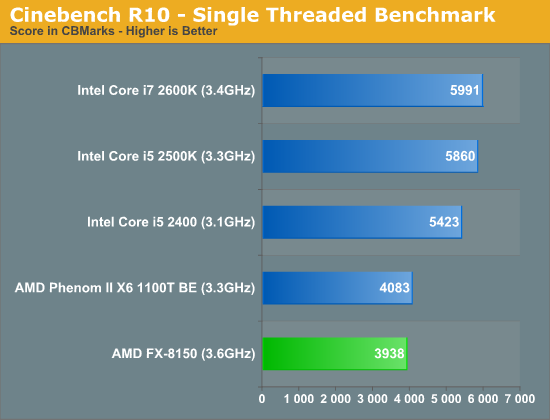
As I alluded to earlier, single threaded performance is going to be a bit of a disappointment with Bulldozer and here you get the first dose of reality. Even considering its clock speed and Turbo Core advantage, the FX-8150 is slower than the Phenom II X6 1100T. Intel's Core i5 2500K delivers nearly 50% better single threaded performance here than the FX-8150.
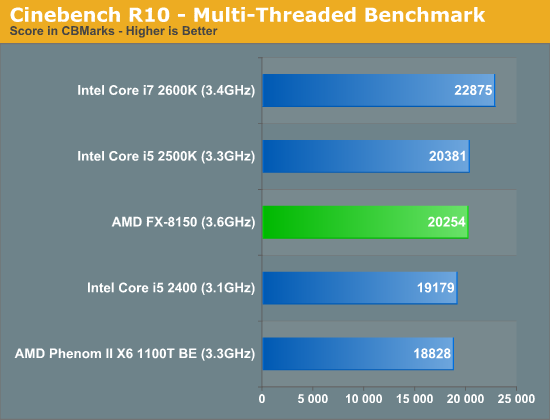
Crank up the threads and the FX-8150 shines, finally tying the 2500K at a comparable price point.
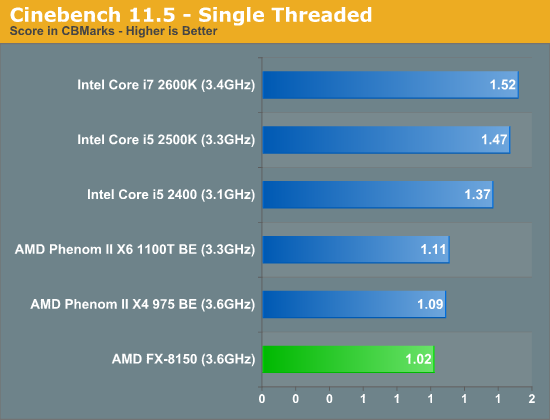
Even with more modern workloads, the FX-8150 isn't able to compete in single threaded speed. Here the 2500K is 44% faster.
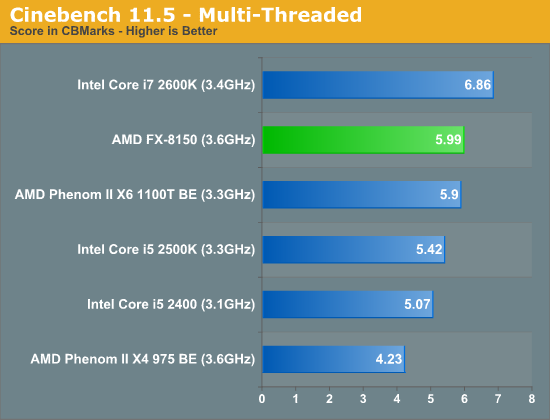
Modern multithreaded workloads however do quite well on Bulldozer. The gains over the old Phenom II X6 1100T are unfortunately not as large as we would expect them to be.
7-Zip Benchmark
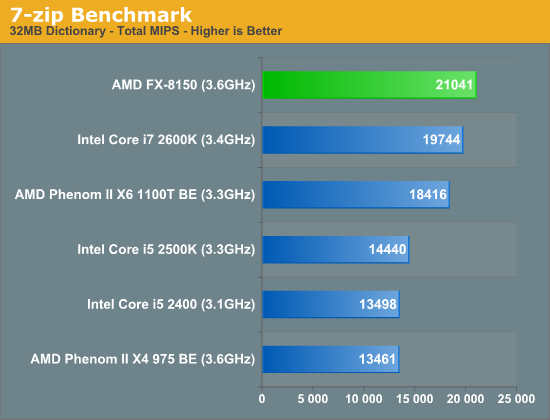
Heavily threaded workloads obviously do well on the FX series parts, here in our 7-zip test the FX-8150 is actually faster than Intel's fastest Sandy Bridge.
PAR2 Benchmark
Par2 is an application used for reconstructing downloaded archives. It can generate parity data from a given archive and later use it to recover the archive
Chuchusoft took the source code of par2cmdline 0.4 and parallelized it using Intel’s Threading Building Blocks 2.1. The result is a version of par2cmdline that can spawn multiple threads to repair par2 archives. For this test we took a 708MB archive, corrupted nearly 60MB of it, and used the multithreaded par2cmdline to recover it. The scores reported are the repair and recover time in seconds.
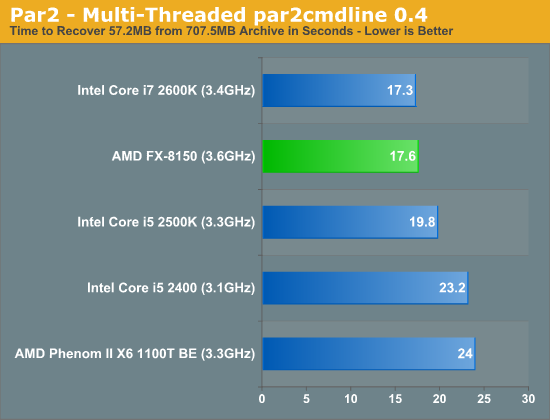
Once again, throw more threads at the processor and the FX-8150 can outperform the Core i5 2500K.
TrueCrypt Benchmark
TrueCrypt is a very popular encryption package that offers full AES-NI support. The application also features a built-in encryption benchmark that we can use to measure CPU performance with:
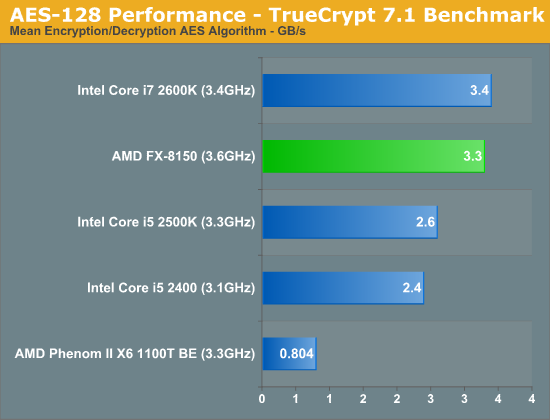
Bulldozer adds AES-NI acceleration, a feature that wasn't present in the Phenom II X6. As a result the FX-8150 is among the fastest at real time AES encryption/decryption, second only to the 2600K. Intel's artificial segmentation using Hyper Threading comes back to haunt it here as the 2500K is significantly slower than the 8-threaded beast.
x264 HD 3.03 Benchmark
Graysky's x264 HD test uses x264 to encode a 4Mbps 720p MPEG-2 source. The focus here is on quality rather than speed, thus the benchmark uses a 2-pass encode and reports the average frame rate in each pass.
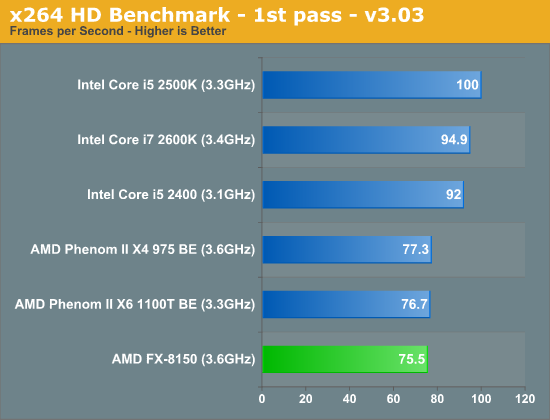
As I mentioned earlier, the first pass of our x264 HD benchmark is a lightly threaded task. As such, the FX-8150 doesn't do very well here. Even the old Phenom II is able to inch ahead of AMD's latest. And Sandy Bridge obviously does very well.

The second pass is more thread heavy, allowing the FX-8150 to flex its muscle and effectively tie the 2600K for first place.
AMD also sent along a couple of x264 binaries that were compiled with AVX and AMD XOP instruction flags. We ran both binaries through our x264 test, let's first look at what enabling AVX does to performance:
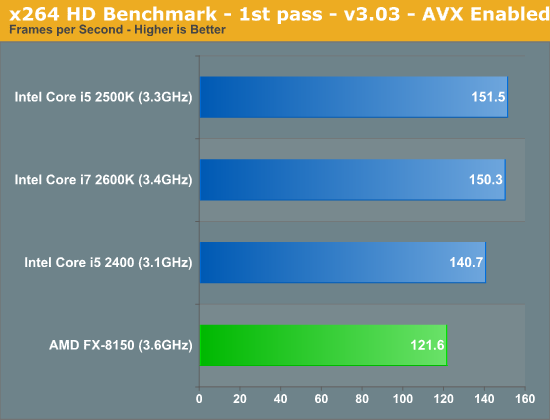
Everyone gets faster here, but Intel continues to hold onto a significant performance lead in lightly threaded workloads.
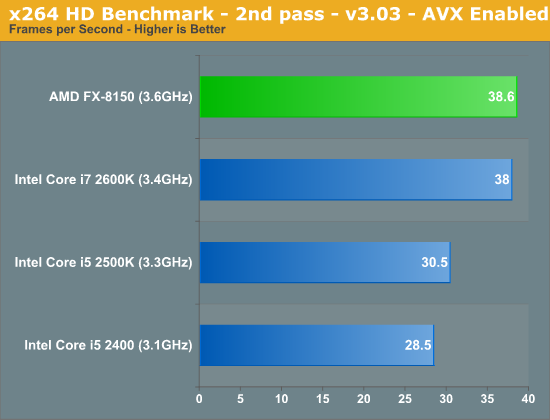
The standings don't change too much in the second pass, the frame rates are simply higher across the board. The FX-8150 is an x86 transcoding beast though, roughly equalling Intel's Core i7 2600K. Although not depicted here, the performance using the AMD XOP codepath was virtually identical to the AVX results.
Adobe Photoshop CS4
To measure performance under Photoshop CS4 we turn to the Retouch Artists’ Speed Test. The test does basic photo editing; there are a couple of color space conversions, many layer creations, color curve adjustment, image and canvas size adjustment, unsharp mask, and finally a gaussian blur performed on the entire image.
The whole process is timed and thanks to the use of Intel's X25-M SSD as our test bed hard drive, performance is far more predictable than back when we used to test on mechanical disks.
Time is reported in seconds and the lower numbers mean better performance. The test is multithreaded and can hit all four cores in a quad-core machine.
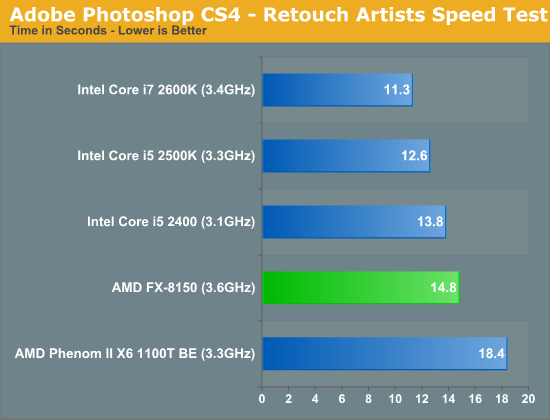
Photoshop performance improves tangibly over the Phenom II X6, unfortunately it's not enough to hang with the enthusiast Sandy Bridge parts.
Compile Chromium Test
You guys asked for it and finally I have something I feel is a good software build test. Using Visual Studio 2008 I'm compiling Chromium. It's a pretty huge project that takes over forty minutes to compile from the command line on a dual-core CPU. But the results are repeatable and the compile process will easily stress more than 8 threads on a CPU so it works for me.
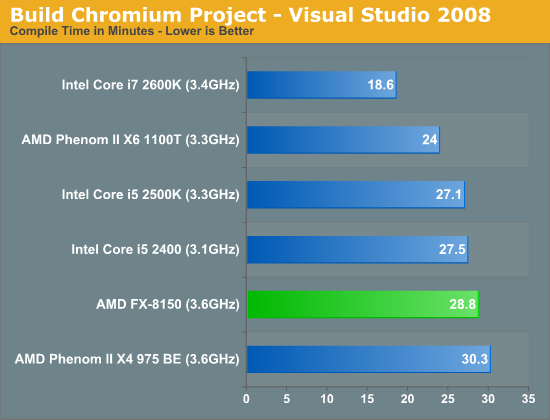
Our compiler test has traditionally favored heavily threaded architectures, but here we found the Phenom II X6 1100T to offer a tangible performance advantage over Bulldozer. While AMD is certainly competitive here, this is an example of one of those situations where AMD's architectural tradeoffs simply don't pay off—not without additional clock speed that is.
Excel Monte Carlo

Our final application test is another win for AMD over the Core i5 2500K. The victory is entirely a result of Intel's Hyper Threading restrictions though, the eight-thread 2600K is able to easily outperform Bulldozer. Either way, AMD delivers better performance here for less money.










430 Comments
View All Comments
ThaHeretic - Saturday, October 15, 2011 - link
Here's something for a compile test: build the Linux kernel. Something people actually care about.Loki726 - Monday, October 31, 2011 - link
The linux kernel is more or less straight C with a little assembly; it is much easier on a compiler frontend and more likely to stress the backend optimizers and code generators.Chromium is much more representative of a modern C++ codebase. At least, it is more relevant to me.
nyran125 - Saturday, October 15, 2011 - link
Whats the point in having 8 cores, if its not even as fast as an intel 4 core and you get better performance overall with intel.. Heres the BIG reality, the high end 8 core is not that much cheaper than a 2600K. Liek $20-60 MAX> Youd be crazy to buy an 8 core for the same price as an intel 2600K...LIKE MAD!!!
Fiontar - Saturday, October 15, 2011 - link
Well, these numbers are pretty dismal all around. Maybe as the architecture and the process mature, this design will start to shine, but for the first generation, the results are very disappointing.As someone who is running a Phenom II X6 at a non-turbo core 4.0 Ghz, air cooled, I just don't see why I would want to upgrade. If I got lucky and got a BD overclock to 4.6 Ghz, I might get a single digit % increase in performance over my Phenom II X6, which is not worth the cost or effort.
I guess on the plus side, my Phenom II was a good upgrade investment. Unless I'm tempted to upgrade to an Intel set up in the near future, I think I can expect to get another year or two from my Phenom II before I start to see upgrade options that make sense. (I usually wait to upgrade my CPU until I can expect about a 40% increase in performance over my current system at a reasonable price).
I hope AMD is able to remain competitive with NVidia in the GPU space, because they just aren't making it in the CPU space.
BTW, if the BD can reliably be overclocked to to 4.5Ghz+, why are they only selling them at 3.3 Ghz? I'm guessing because the added power requirements then make them look bad on power consumption and performance per watt, which seems to be trumping pure performance as a goal for their CPU releases.
Fiontar - Saturday, October 15, 2011 - link
A big thumbs down to Anand for not posting any of the over-clock benchmarks. He ran them, why not include them in the review?With the BD running at an air cooled 4.5 Ghz, or a water cooled 5.0 Ghz, both a significant boost over the default clock speed, the OC benchmarks are more important to a lot of enthusiasts than the base numbers. In the article you say you ran the benchmarks on the OC part, why didn't you include them in your charts? Or at least some details in the section of the article on the Over-clock? You tell us how high you managed to over-clock the BD and under what conditions, but you gave us zero input on the payoff!
Oscarcharliezulu - Saturday, October 15, 2011 - link
...was going to upgrade my old amd3 system to a BD, just a dev box, but I think a phenom x6 or 955 will be just fine. Bit sad too.nhenk--1 - Sunday, October 16, 2011 - link
I think Anand hit the nail on the head mentioning that clock frequency is the major limitation of this chip. AMD even stated that they were targeting a 30% frequency boost. A 30% frequency increase over a 3.2 GHz Phenom II (AM3 launch frequency i think) would be 4.2 GHz, 17% faster than the 3.6 GHz 8150.If AMD really did make this chip to scale linearly to frequency increases, and you add 17% performance to any of the benchmarks, BD would roughly match the i7. This was probably the initial intention at AMD. Instead the gigantic die, and limitations of 32nm geometries shot heat and power through the roof, and that extra 17% is simply out of reach.
I am an AMD fan, but at this point we have to accept that we (consumers) are not a priority. AMD has been bleeding share in the server space where margins are high, and where this chip will probably do quite well. We bashed Barcelona at release too (I was still dumb enough to buy one), but it was a relative success in the server market.
AMD needs to secure its spot in the server space if it wants to survive long term. 5 years from now we will all be connecting to iCloud with our ARM powered Macbook Vapor thin client laptops, and a server will do all of the processing for us. I will probably shed a tear when that happens, I like building PCs. Maybe I'll start building my own dedicated servers.
The review looked fair to me, seems like Anand is trying very hard to be objective.
neotiger - Monday, October 17, 2011 - link
"server space where margins are high, and where this chip will probably do quite well."I don't see how Bulldozer could possibly do well in the server space. Did you see the numbers on power consumption? Yikes.
For servers power consumption is far more important than it is in the consumer space. And BD draws about TWICE as much power as Sandy Bridge does while performs worse.
BD is going to fail worse in the server space than it will in the consumer space.
silverblue - Monday, October 17, 2011 - link
I'm not sure that I agree.For a start, you're far more likely to see heavily threaded workloads on servers than in the consumer space. Bulldozer does far better here than with lightly threaded workloads and even the 8150 often exceeds the i7-2600K under such conditions, so the potential is there for it to be a monster in the server space. Secondly, if Interlagos noticably improves performance over Magny Cours then coupled with the fact that you only need the Interlagos CPU to pop into your G34 system means this should be an upgrade. Finally, power consumption is only really an issue with Bulldozer when you're overclocking. Sure, Zambezi is a hungrier chip, but remember that it's got a hell of a lot more cache and execution hardware under the bonnet. Under the right circumstances, it should crush Thuban, though admittedly we expected more than just "under the right circumstances".
I know very little about servers (obviously), however I am looking forward to Johan's review; it'd be good to see this thing perform to its strengths.
neotiger - Monday, October 17, 2011 - link
First, in the server space BD isn't competing with i7-2600K. You have to remember that all the current Sandy Bridge i7 waste a big chunk of silicon real estate on GPU, which is useless in servers. In 3 weeks Intel is releasing the 6 core version of SB, essentially take the transistors that have been used for GPU and turn them into 2 extra cores.Even in highly threaded workloads 8150 performs more or less the same level as i7-2600K. In 3 weeks SB will increase threaded performance by 50% (going from 4 cores to 6). Once again the performance gap between SB and BD will be huge, in both single-threaded and multi-threaded workloads.
Second, BD draws much higher power than SB even in stock frequency. This is born out by the benchmark data in the article.